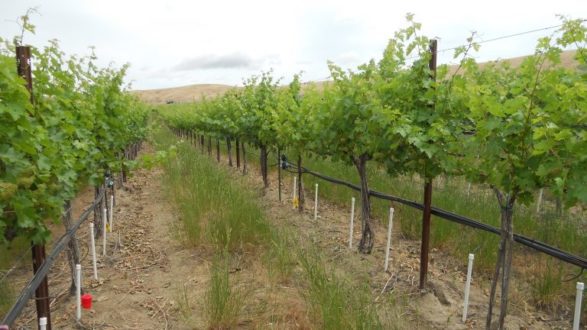Aug 8, 2019New irrigation system can cut vineyard water usage by 35%
Washington State University (WSU) professor of Crops and Soil Sciences, Pete Jacoby, has invented and developed a subsurface irrigation system that could be game-changing for Washington’s winegrape industry.


Launched in 2015, Jacoby’s Direct Root-Zone irrigation (DRZ) system differs from existing micro-irrigation models in significant ways. Whereas common drip irrigation systems deliver water in horizontally buried lines, the DRZ system feeds water into vertical tubes buried 1– 4 feet directly into the root-zone soil. Not only does the DRZ supply water to vines much more efficiently than traditional micro-irrigation systems, its vertical structure is less susceptible to damage from clogs, burrowing rodents, or curious wildlife. “Coyotes will teethe on dripline hoses,” Jacoby said
After securing an initial grant in 2014, Jacoby needed to execute field trials. “We wanted to see the dynamics of how this would work,” he said. “It was our hypothesis we could save water.” For the DRZ proof-of-concept studies, Jacoby had to enlist growers willing to hand over vineyard acreage for the experiments. One of the first growers he approached was Scott Williams of Kiona Vineyards.
A second-generation winemaker, Coug, and 2019 Washington Grower of the Year, Williams agreed. “If you can show me how to save water,” he told Jacoby, “I’ll let you use some of my vineyard.” Williams provided about 1 ¼ acres. Another nearby large-scale vineyard offered the same amount of acreage, allowing Jacoby to conduct duplicate studies. The team then conducted research during the 2015 – 2017 growing seasons with a focus on eight-year old Cabernet Sauvignon grapes.
Redefining deficit irrigation
Wine-grape growers practice deficit irrigation, a sustainable, effective and commonly used method in vineyards that “stresses” vines, eventuating a balance between vegetative and reproductive growth, optimal fruit quality and yield, and water conservation. The number of growers using either surface or subsurface drip irrigation as part of their deficit watering management plans has increased in the past few years, paving the way for potentially more efficient systems like Jacoby’s DRZ. Recent studies even showed Jacoby’s DRZ outperforming surface drip systems which are considered, “the gold standard” in the industry.
Collaborating with Sindhuja Sankaran and Lav Khot – professors in WSU’s department of Biological Systems Engineering – Jacoby secured another significant grant in 2015 for using drone technology and remote sensing to monitor the variable stress the project’s grapevines were undergoing at any given time. Again, his results have been very promising.
Broader application
After tracking significant results, securing grants, and publishing four major papers on the DRZ, Jacoby is confident that his system will not only be a vital irrigation option for growers in arid south-central Washington, but it could have broader, more global appeal and application as well. In fact, shortly after inventing his system, Jacoby stumbled upon a paper out of Libya where researchers there were trying to use similar styles of irrigation for table grapes. “They did a minor study at a little experiment station and found that they could pour half the water into a pipe and get a better result than pouring all of the water on top of the soil,” Jacoby said. “They were thinking along similar lines.” The DRZ could be just as innovative in places like California and Oregon as it could be in the Mediterranean.
Locally, two critical factors make professor Jacoby’s invention both attractive and timely. First, Washington’s wine industry is booming, with over 900 wineries operating statewide and some 70 wine grape varieties being produced. Second, the majority of the industry’s vineyards are located in Washington’s arid steppe climate that requires supplemental irrigation, and average annual rainfall is about 200 mm. Direct Root-Zone irrigation, Jacoby believes, will help ensure the industry’s forward momentum by offering growers a sustainable tool that will save both money and water without sacrificing the quality of the wine grapes. “Our system used 35% less water,” he added, “and that number is conservative.
– Washington State University
Photo at top: Direct Root-Zone irrigation tubes feeding grapevines individually. Photo: Washington State University















